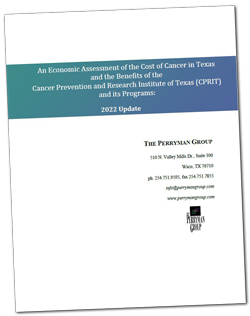Cost of Cancer
Cancer takes a toll on all Texans, physically, emotionally, and economically. While the established purpose of CPRIT is to attack the physical and emotional toll of this disease by supporting expanded research, improved treatments and cures, our programs also reduce the economic impact. This section looks at the economic cost of cancer to all Texans and how CPRIT’s work provides a return on investment.
Texas pays for cancer through reduced annual spending, output losses, and lost jobs attributable to cancer treatment, morbidity and mortality, and the associated spillover effects. The Perryman Group updated its economic assessment of the annual cost of cancer in Texas and the benefits of CPRIT and its program for fiscal year 2022.
 Read the Perryman Group Report
Read the Perryman Group ReportDirect medical costs and morbidity/mortality losses
Total economic losses, including multiplier effects
Lost jobs, including multiplier effects
State Funds Expended by Initiative/Organization
Non-State Funds Expended by Initiative/Organization
* Most recent information available
Basic medical research is part of society’s essential infrastructure and is valuable to society in large part due to what it facilitates downstream. By enhancing Texas’ cancer research prowess, expanding the life science infrastructure and prevention ecosystem throughout the state, and accelerating innovative cancer discoveries and prevention strategies, CPRIT enhances the health of Texans and the economy at a pace that far exceeds the state’s direct investment.
Cost Savings in Treatment and Early Detection
Economic Activity (Total Expenditures)
Output (Real Gross Product)
Personal Income
Retail Sales
State Tax Receipts
Local Government Tax Receipts
In addition to serving as a stable source of cancer research and product development funding, the money CPRIT invests in cancer research and development positions its grantees to be more competitive for external funding. Sources of external funding include grants from the National Institutes of Health, Department of Defense, National Science Foundation, the American Cancer Society, and other cancer granting organizations that support scientists at universities and non-profit research organizations. Other sources of financial support for early-stage biotech companies include angel investors, family foundations, venture capital, and federal grants (e.g., the NCI Small Business Innovative Research and Small Business Technology Transfer program).
Non-CPRIT grants received by grantee institutions to continue CPRIT projects
Follow-on capital raised by CPRIT-funded companies
Ratio of follow-on capital raised compared to CPRIT’s company investments